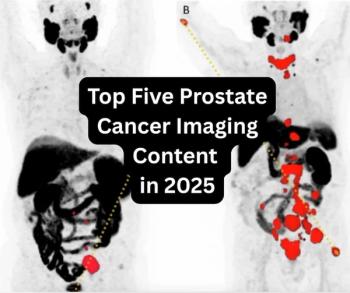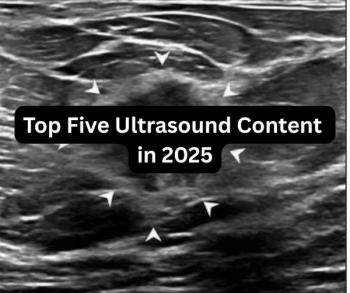Contrast-enhanced mammography (CEM) research shows that premenopausal status, hormone replacement therapy (HRT) and lactation are all associated with higher grades of background parenchymal enhancement (BPE).
For the retrospective study, recently published in Radiology, researchers reviewed CEM data from 507 patients (mean age of 49.8). Nearly half of the cohort (49.1 percent) had a family history of breast cancer, 17.8 percent had a history of a high-risk lesion and 13 percent had a BRCA mutation, according to the study.
The study authors found that 46 percent of premenopausal patients had high BPE (moderate or marked) in contrast to 16 percent of postmenopausal patients. They added that premenopausal women also had a higher median BPE grade in comparison to postmenopausal women (1.0 vs. 0).
Researchers also noted that 94 percent of lactating women had high BPE, which occurred in 42 percent of non-lactating premenopausal controls. Fifty percent of patients on hormone replacement therapy (HRT) had high BPE in comparison to 14 percent for postmenopausal controls without HRT, according to the study authors.
They added that lactating women had a higher median BPE grade than non-lactating patients (3.0 vs. 1.0), and patients on HRT had a higher median BPE grade than postmenopausal controls (1.5 vs. 0).
“ … The results of this study show the association between background parenchymal enhancement observed at contrast-enhanced mammography (CEM) and hormonal factors across different physiologic stages and pharmacologic interventions, stressing the necessity for clinical correlation in CEM interpretation,” wrote lead study author Noam Nissan, M.D., who is affiliated with the Department of Radiology at the Memorial Sloan Kettering Cancer Center in New York, N.Y., and colleagues.
While noting similarities between their CEM study and that of breast MRI research with respect to the impact of hormonal states upon BPE, the researchers point out key differences between the modalities with image acquisition.
“Unlike MRI, during which both breasts are imaged simultaneously, CEM is performed in multistep acquisition and the positioning process may introduce timing differences in the images captured for each breast,” explained Nissan and colleagues. “Dynamic contrast-enhanced MRI is also performed at multiple time points, including early wash-in phases, on ultrafast sequences. (As) BPE is characterized by a gradual increase in intensity and breast cancer by a rapid wash-in phase, the additional early acquisitions provided by ultrafast MRI can potentially improve cancer detection in patients with high levels of BPE before the BPE reaches its peak.”
Three Key Takeaways
1. Hormonal influence on BPE. Premenopausal women, those on hormone replacement therapy (HRT), and lactating women exhibit significantly higher grades of background parenchymal enhancement (BPE) on contrast-enhanced mammography (CEM), suggesting a strong hormonal influence on BPE levels.
2. Lactation and HRT impact. Lactating women had the highest proportion of high BPE (94 percent), followed by patients on HRT (50 percent). The findings reinforce the need to account for these physiological and pharmacologic factors when interpreting CEM.
3. Clinical implications for interpretation. Understanding the dynamic nature of BPE in response to hormonal states can help radiologists improve CEM interpretation, potentially reducing unnecessary follow-ups and enhancing cancer detection accuracy.
The study authors also found that high BPE on CEM occurred in nine percent of patients taking the selective estrogen receptor modulator tamoxifen in comparison to 31 percent of non-tamoxifen controls.
“By demonstrating the changes of BPE in response to hormonal regulation, our findings add to the complexity of the nature of BPE as it is a dynamic rather than constant factor. To minimize further diagnostic interventions, it is crucial to understand its hormonal modulation and how it uniquely manifests in the subgroups studied. Familiarity with these variations can help radiologists make more accurate interpretations and reduce unnecessary follow-ups,” emphasized Nissan and colleagues.
(Editor’s note: For related content, see “Long-Term Study Shows Merits of Contrast-Enhanced Mammography for Women with Higher Breast Cancer Risk,” “Can AI Automate BPE Assessment of Dense Breasts on mRI?” and “Is the Kaiser Score More Effective than BI-RADS for Assessing Contrast-Enhanced Mammography and MRI?”)
Beyond the inherent limitations of a retrospective, cross-sectional study, the authors noted the possibility of some reviewed cases not having documentation of lactation, HRT or tamoxifen use in radiology reports. Acknowledging that screening CEM is primarily reserved for women with dense breasts, the researchers suggested that pre- and postmenopausal controls may have had higher BPE grades than the broader population. The study authors conceded variability in dosing and route administration of HRT.





























